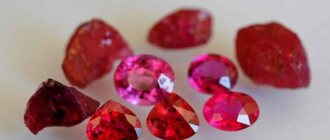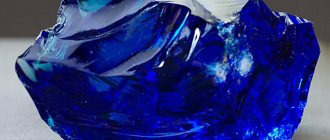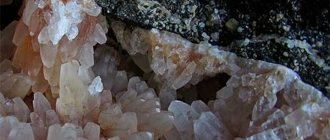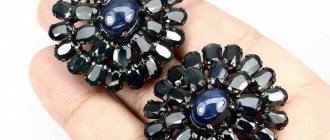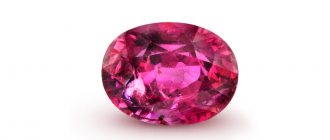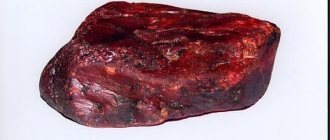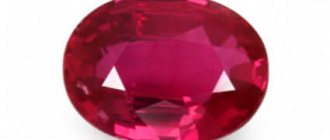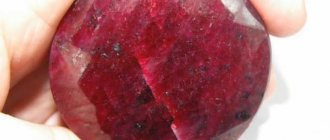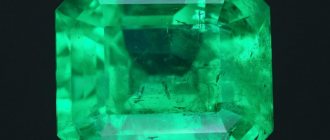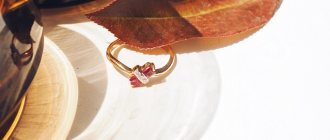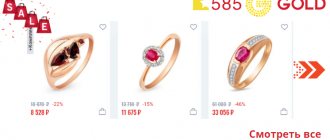| Category | Oxides |
| Title in English | Ruby |
| Formula | Al2O3 |
| Group | Corundum group |
| Color | Red, Red-brown, Red-purple, Red-pink |
| Stroke color | White |
| Shine | Glass |
| Transparency | Transparent |
| singonia | Trigonal |
| Hardness | 9 |
| Cleavage | Imperfect |
| Density, g/cm³ | 3,99 — 4,10 |
| Kink | Conchoidal |
| origin of name | The name for this corundum was created from the Latin word rubens or also rubinus, which translates as blushing. |
Ruby is a variety of corundum, namely aluminum (III) oxide with chromium impurities, which gives it an unusual red hue. Artificial ruby was first synthesized by the French chemist O. Verneuil in 1904. Rubies have found use in the jewelry and watch industries, as well as in quantum electronics.
Ruby deposits
Deposits of this precious stone are located on all continents, with the exception of Antarctica.
The most ancient of them were discovered in the Pamirs (Snezhnoye, Tajikistan). — Advertising —
The main modern exporting countries are Myanmar, Thailand and Sri Lanka. Rubies found in eastern Africa (Kenya, Tanzania) are also of good quality.
As an accompanying material, rubies are found in the south of the Urals, in the north of Karelia, and on the Kola Peninsula.
Colors and varieties
The most common color is red, but there are others.
The most common type of stone, of course, is the red ruby, the color of wine or blood. A gem can also be:
- fiery golden;
- red-brown;
- pink - stones of this shade are often confused with spinel.
The most valuable variety of ruby is the so-called “pigeon blood”, a gem with a purple or bluish tint. Despite the fact that the stone is similar in composition to sapphire, it cannot boast such a variety of shades.
Star ruby is also highly prized. Its edges form a unique pattern. If you shine a light on them, you will notice that a six-rayed star is burning in the center of the stone. They said about such rare corundums that they were the work of powerful sorcerers of antiquity, who could enclose stars from the sky in their magic crystals.
Another interesting rock is called anionite. It contains elements of pinkish ruby and zoisite, its green relative. Together they form a crystal with a unique design that any jeweler will happily take on.
Ruby history
During the Middle Ages in Rus', rubies were not distinguished from sapphires and both stones were called “yakhonts”.
The phonetic path of this word began with the Greek “yaksintos”, which passed into the Persian “yakund”, then into the Arabic “yakut” and the Slavic “yakhont”. And the word "ruby" comes from the Latin "rubeus", which refers to its red color. Rubies have been known to man for a very long time; they were mined in Burma during the Bronze Age. These stones were valued and used as talismans in Ancient India, Greece and Rome. Thus, in the main temple of the ancient Greek city of Hierapolis there was a gilded statue of Zeus’s wife, Hera, decorated with large rubies. In the Middle Ages, rubies were recognized as a symbol of Fire, and the sun was considered its patron.
— Advertising —
A related line of rubies and sapphires was discovered in 1800 in Europe. And in 1960, scientists first created a solid-state laser using this stone.
Ruby gemstone
Ruby
One of the most sought after gemstones today was known thousands of years ago.
Then people did not know how to distinguish minerals of similar color, classifying all red minerals as rubies. The ancient Indians considered it the stone of the Sun and called it nothing more than “the leader of gems.” In European countries, ruby was the patron of the brave and courageous, knights devoted to ideals. In the countries of the East, the red stone was considered the blood of the Dragon and symbolized vital energy, bringing strength, love and health.
Properties of the stone
Ruby is one of the varieties of red corundum. The shade of the mineral varies from bright pink to deep red and depends on the amount of chromium impurities. The most valuable and rare corundums are considered to be “the color of pigeon’s blood”, which have a purple tint.
Ruby is a first category gemstone and its composition is similar to sapphire. This mineral is second only to diamond in strength. Ruby has a hardness rating of 9 on the Mohs scale.
Red corundum crystals have a high degree of transparency and luster. No other precious mineral has such characteristics except diamond. Thanks to these properties, a large ruby can cost even more than a similar-sized diamond.
In appearance, a ruby resembles a red spinel and is sometimes distinguishable from it only under a microscope. Also, red corundum can be easily confused with garnet, hyacinth zircon, topaz and tourmaline.
Minerals with rutile inclusions, similar to stars, are of high value. Such stones are very rare and therefore expensive.
In the mid-19th century, a method for producing artificial rubies was discovered. Currently, artificial red corundum is used in the manufacture of watches and jewelry, as well as in quantum electronics as a laser element.
How to determine the quality of a ruby
The cost of a natural ruby is quite high, so there is no need to rush when purchasing jewelry with this precious stone.
Centuries later, even some royal regalia rubies are being “exposed.” Thus, as a result of modern research, fake rubies were discovered in jewelry belonging to the royal family of England. The famous "Black Prince's Ruby" adorning the British crown turned out to be just a red spinel. What can we say about our time? However, there are three ways to help you determine the quality of a mineral.
1 way. When buying jewelry with a ruby, be sure to look at the stone not only in artificial light, but also in daylight. Good quality rubies have almost the same hue in any light, while lesser quality rubies turn pale pink in daylight.
Method 2. Examine the stone under a magnifying glass. Natural corundum has inclusions and small imperfections, while synthetic stones appear clear, like glass.
3 way. Add lemon juice to the corundum. If the stone is real, it will remain unchanged. Otherwise, cloudy inclusions will appear on the stone.
If you buy very expensive jewelry with rubies, it is better to contact a professional gemologist who will evaluate the quality of the stone using special equipment. Experts also advise purchasing products with precious stones from well-known manufacturers who can provide all the necessary information about the stone.
Mining rubies
There are many deposits of rubies. Red corundum is not mined except in Antarctica. But only 1% of the mined minerals are of jewelry quality.
Until now, rubies are mined using ancient technologies known for many hundreds of years. This labor-intensive process is carried out manually by washing sand and pebbles. Often stones are taken directly from the bottom of rivers.
Rubies of Asian origin are of great value. Burma is considered the oldest deposit. It is Burmese rubies that are valued above others due to their rare coloring. Indian ruby placers are also known, which are also considered very ancient. For many centuries, these stones were used to inlay jewelry of high society.
Now, in addition to India and Burma, the main exporters of red corundum are Thailand, Sri Lanka, Tanzania, Tajikistan and Afghanistan. In Russia, this stone is mined only in the Polar Urals.
Thai rubies have a brownish tint. They are mined in Changvad at a depth of 8 meters. Corundums mined in Sri Lanka are usually a bright strawberry color. Local people call these stones "illam".
Choice of stars
Beauty knows no time. From the ancient jewelry of the royal family, rubies moved into the collections of leading designers. Nowadays, the stone adorns not only luxurious works of jewelry, but also products that any woman can afford.
High quality red corundums are usually cut into a brilliant cut or cabochon cut. Most often, the setting for rubies is white or red gold. If the product is inlaid with different types of stones, the combination of ruby and diamond is considered the most elegant and brilliant.
Celebrity beauties often choose ruby accessories for going out. Famous fans of this stone include Jennifer Lopez, Miley Cyrus, Natalie Portman and Kelly Osbourne. But Jessica Simpson received a ruby ring from famous football player Eric Johnson along with a marriage proposal.
Record ruby
Some of the largest and most beautiful rubies were mined in Myanmar near Mogok.
Large rubies are a rare occurrence; even a weight of 35-40 carats is unique for them. One of the largest Indian rubies weighed 951 carats. The Sun of Mogok (1,743 carats) and Navara Ruby (504.5) rubies are kept in Myanmar. The Los Angeles Historical Museum protects the Nixon Ruby stone (196 carats). A record price ($30 million) ruby with a pigeon's blood color and weighing 25.59 carats was sold at Sotheby's auction in 2015.
Product care rules
Although ruby is a very durable stone, you should still be careful when using jewelry:
- The mineral does not like scorching sun rays, household chemicals or perfumes.
- Remove dirt from the product with a soft brush dipped in a light soap solution. You must first soak the stone in water for half an hour.
- Each piece of jewelry should be stored separately, in a box with soft walls. Neighborhood with minerals of equal cost is allowed.
It is not recommended to wear ruby jewelry all the time; a person needs rest. The strong energy of ruby with prolonged contact leads to overexcitation of the nervous system.
Physico-chemical characteristics of ruby
Ruby is basically corundum, aluminum (III) oxide.
Its color is due to the presence of chromium, ferum, and titanium in the mineral and varies from red, pink-red to purple-red of varying degrees of saturation. The stone is translucent, transparent, with shine. In terms of hardness - second place after diamond, on the Mohs scale - 9. It does not have cleavage, which is why it is resistant to breaking and mechanical stress. The fracture is conchoidal and uneven.
The syngony of ruby is trigonal. Habit: hexagonal flat plates or columnar.
The density of the stone is from 3.97 to 4.05. Light refraction: 1.766-1.774.
Checking at home
There are several interesting methods to help determine the authenticity of the purchased stone at home. It’s better to try them together for a full analysis:
- Place it in a transparent glass of water and if it does not start playing with red rays, then this is not a real stone.
- You can put it in a glass of milk. Natural specimens give milk a pinkish tint due to pronounced color refraction.
- Hold the mineral in your palm. If it maintains its original temperature for a long time, then this is a natural gem.
- Take the needle and move it firmly across the pebble. If it remains intact, it means you made the right purchase. If there is a scratch, then this is a fake.
- High density determines the severity of the mineral. Small natural stones weigh significantly heavier than ordinary painted glass.
Types of ruby
Typically, only red, richly colored corundums are considered rubies.
Pink varieties belong to the sapphire group. In nature, young stones of light pink or lilac color are rarely found. The color is directly related to the deposit, for example, Myanmar rubies are always bright red, occasionally with a lilac tint. A purple tint is typical for stones in Vietnam, while in Thailand the mineral has dark red or even brown shades.
An interesting variety is the star ruby with a beautiful six-pointed star in the center of the stone. Sometimes there is even a double star.
Ruby inclusions contain an anolite stone consisting of green zoisite. It is mined in Tanzania.
But the black ruby is not actually a ruby, it is a type of spinel.
Gradation by quality and price of rubies
The fiery red ruby is rightfully the epitome of perfection. Jewelry connoisseurs rate this stone quite highly. The cost of some large specimens sometimes exceeds the cost of diamonds of the same size.
Rubies are:
- red with dark and light shades;
- pink;
- scarlet;
- purple.
The precious crystal can have orange, purple and black glitter.
There are stones of amazing shape and color intensity. There are slightly cloudy specimens and opaque ones, star-shaped and with a cat's eye effect. Some types of crystals are not cut, but polished, giving them a convex shape. Burmese rubies are still famous for their particularly beautiful and expensive specimens. The price of one carat can start from 50 and reach 5,000 US dollars.
Indian corundums differ from stones from other deposits in their light shade and the presence of cracks and specks in the stone. Because of this, the cost of stones is much lower.
Tanzanian rubies are particularly dark and monochromatic. This classifies the mineral as second grade. But some stones have a bright garnet hue and after cutting, garnet rubies become worthy of attention.
Precious crystals from Kenya, Madagascar, and Afghanistan have amazing reflections and effects, although they are much less expensive.
Modern technologies make it possible to grow red corundum artificially. The resulting crystal is not inferior to natural ruby in appearance and quality. The synthetic mineral is widely used for industrial purposes. To distinguish a natural ruby from a man-made one, simply dip it in milk - the surface turns pink.
Magic properties
Fire is the native element of rubies.
The stone protects its owner even in the midst of ill-wishers and makes him invulnerable. For this purpose, the ruby is worn on the body, hidden by clothing, and the amulet is not removed. But it is worth considering that the influence of the stone depends on the qualities of the person: thus, a ruby makes a kind, good owner noble and persistent in the pursuit of a goal, and only strengthens the negative character traits of evil people.
Rubies are responsible for leadership and responsibility, they help overcome complexes and lack of self-confidence, awaken love and craving for great things, arts, sciences, and military affairs.
Ruby also symbolizes passionate carnal love.
Ruby Magic
This red gem is a stone of power. It has always been worn by people who have reached a high position, on whom the position of other people depends.
Esotericists have long believed that the magic of a ruby does not change a person. It only strengthens his character traits - both good and bad. Here the meaning of the stone is to be a catalyst for human qualities.
Ring with ruby
Therefore, a person with evil thoughts should not wear items made of red ruby. In this regard, the stone is “unprincipled”; it always indulges the passions of its owner. Whether it’s passionate love or the same passionate desire to ruin a rival by any means, to harm a rival... It’s better not to wish harm on your neighbors (and those far away too).
- Ruby is a stone of brilliance and vanity, pride and creative success.
- But these magical properties of the stone can energetically devastate the owner.
- Active, energetic people will find a harmonious ally in the gem.
- Ruby, its fiery color carries the symbolism of love, passion and fidelity.
- The magical properties of ruby protect the owner of the stone from evil forces and from astral attacks.
- If the color or shine of a gem has changed, this means you should be wary. These are signs of possible danger.
- Dedicated magicians love ruby - the stone gives them strength and power over the lower astral plane.
- Fire is the element of ruby. And the flames of passions are subject to the flame-colored stone.
- It is important to know that ruby is a symbol of love, but carnal love.
We recommend: EMERALD AND BERYL: are they the same thing?
Interesting: some esotericists believe that the property of the ruby (lonely) is to attract loneliness. That is why it is recommended to wear rubies in pairs.
All properties apply only to real gems.
Applications
As a category I gemstone, ruby is used to make expensive jewelry.
Synthetic ruby is used for inexpensive products and watch movements. It was also used in 1960 as the light-emitting active medium in Theodore Maiman's first laser, and has been used in that direction ever since.
Rubies in Russia and the rest of the world
In describing the characteristics of ruby, Russia has “its own, special path of development.” Jewelers around the world use the GIA system.
Ruby Jewelry
According to Russian technical specifications, the main characteristics of the gem:
- color;
- purity.
The definition of color is divided into hue, lightness, saturation.
The GIA tables and methodology apply to more than just rubies. It can be used to determine the quality of any gemstone.
Ruby colors
Based on color, rubies are divided into the following groups:
- bright red;
- red;
- medium red;
- dark red;
- light red.
The less chromium it contains, the paler the color.
The most valuable shade is the color of pigeon blood, which combines purple and violet shades.
What family is ruby from?
The family is called Corundi and contains several eminent "relatives".
Types of mineral:
- corundum is an opaque, granular, grayish stone;
- sapphires, crystals from blue to deep blue:
- ruby, pink to dark red in color;
- leucosapphire - transparent colorless crystals are found;
- green corundum, “oriental emerald”;
- violet corundum, “oriental amethyst”;
- Padparadschi, a stone of orange-yellow, greenish-yellow color.
Corundum crystals - sapphire and ruby - are twins in composition. The whole difference is a few percent of chromium oxide (in ruby) and iron, titanium - in sapphire. But what a difference in color! Fire and water, the heat of the flame and the coolness of the sea.
Ruby is a stone of the material world, sapphire is a stone of the spiritual world. But this is already from the realm of esotericism.
Ruby purity and its definition
Finding a perfectly pure ruby without defects or inclusions is not an easy task.
But some of the possible inclusions have a positive effect and increase the price of the stone. These include inclusions that form a six-pointed symmetrical star in the center of the ruby. Such specimens are very rare. Other inclusions reduce the transparency and brilliance of the stone. According to purity, rubies are distinguished:
- Very clean shiny stones with sparse and small dots and stripes;
- Almost pure, shiny, interspersed with foreign minerals, stripes and cracks;
- Opaque with cloudiness in some areas.
Purity assessment is carried out in special laboratory conditions. Transparent, deep red rubies with a violet tint are recognized as the most valuable.
Ruby processing options
Gem enhancement is carried out in several ways:
- heat treatment is necessary to eliminate purple and orange tints, as well as to remove rutile microfibers to improve the visual perception of the jewelry;
- the use of a flux medium makes it possible to “heal” open cracks;
- the use of diffuse processing using a beryllium layer allows you to give the ruby a rich red color;
- filling large cracks with a special glass composition improves color and clarity, but reduces the cost of the gem;
- surface coloring is necessary to change the color characteristics (rarely used in jewelry).
All varieties of ruby are subjected to heat treatment and cutting. Only after processing can the gem be set in gold rings, necklaces, chokers and other jewelry.
Artificial ruby
For the first time, synthetic ruby began to be grown artificially in industrial conditions and is widely used instead of natural ruby for jewelry and technical purposes.
Immediately after extraction, stones are thermally treated, which changes their natural structure; such stones occupy about 4% of the market. They are also created using beryllium dyeing, which makes corundums deep red (1% of the market). The remaining 95% are glass-filled specimens. Their cost is no more than $30 per carat, the price for heat-treated specimens without glass starts from $100 per carat, natural rubies are priced from $500 per carat.
Features of ruby mining
Extraction of minerals is carried out manually. The method remains the same as hundreds of years ago.
The disadvantage of this method is that there is a very high probability of damaging or destroying the ruby. The work requires serious physical effort. But first, a person must obtain a special permit, which is very expensive.
Mining stages:
- Determining suitable terrain. In most cases, people prefer scattering.
- Organization of mines with installation of special equipment for pumping water.
- Excavation of rock, which in most cases is clay. After extraction, the minerals are purified.
This extraction method is not only inconvenient, but also extremely dangerous. Not every person is able to do such colossal work to get a ruby. It is quite difficult to determine the volume of extraction, so individual specialists are hired for the work.
Mining ruby is a very difficult job, taking place in rocks at a depth of up to 30 m. But for many people, this is the only way to survive and earn money.
How to distinguish a real ruby from a fake one
It is quite difficult to distinguish a real ruby.
To do this, it is brought to the light. In bright light, a real stone darkens, but its color and shine remain even and uniform, while an artificial stone either does not change color or becomes lighter and has an uneven shine. An accurate result is obtained by testing using ultraviolet radiation: if the stone turns orange, then it is synthetic.
Also, fake stones break easily and may have even cracks. Cracks on real rubies have jagged, zigzag edges.
Natural ruby leaves scratches on turquoise and garnet, but artificial ruby does not. There are no bubbles in it, or they are the same color as the stone.
Medicinal properties
Uncut ruby
Lithotherapists of our time have described the following healing capabilities of ruby:
- improving the functioning of the immune system;
- wound healing;
- improving blood flow, heart function, improving blood pressure, toning blood vessels;
- improvement of brain functions;
- sedative for stress or depression;
- assistance in the treatment of paralysis, epilepsy, schizophrenia;
- treatment of joint diseases;
- elimination of problems of the digestive system, in particular, treatment of stomach ulcers.
Ruby is considered a hemostatic agent. It also has an antipyretic effect, relieves bad dreams, cures chronic tonsillitis, diseases of the kidneys, liver and spine.
Did you know that medieval Aesculapians used ruby to treat the plague?
A sunbeam passed through a ruby is endowed with healing powers. Healers claim that such light has a positive effect on metabolism, restores tissue, and has an anti-inflammatory effect.
Important!
People suffering from hypertension (high blood pressure) or blood incoagulability (hemophilia) are contraindicated from wearing a ruby!
Ruby-charged water is an effective way to maintain beauty and health. To do this, leave the gem in water overnight, and then drink the liquid or wash it with it. This technique helps to quickly recover from stress, restore strength after illness, or simply maintain natural beauty.
How to care for a ruby
Rubies are stored in dark, cool places, as this gem does not like prolonged exposure to the sun.
Jewelry with rubies is wrapped in soft cloth and stored separately. To clean such jewelry, heat water, stir soap in it, and lower the accessory there for half an hour. Then wipe it with a toothbrush with soft bristles. The solution is washed off and the stone is wiped dry with a soft cloth.
Jewelry with rubies is worn after applying makeup to prevent particles of makeup from getting on the stone.
Who suits the name
Jewelry with ruby
Ruby favors those who are called by the following names:
- Allah. The stone will awaken pure thoughts in her, but will also bring trials into her life to achieve them.
- Benjamin. Ruby will help him improve leadership skills, determination, and a sense of responsibility, eliminating uncertainty and sad thoughts.
- Varvara. For such a girl, the gem will become a love talisman, bringing happiness in matters of the heart.
- Pavel will be able to overcome his complexes, gain leadership qualities, and become responsible with a ruby amulet.
- Faith will gain strength and confidence to achieve your goals. Ruby will help this girl gain recognition, fame, and will also protect family happiness, protect her from troubles and troubles.
- Victor will strengthen his characteristic sense of purpose, dignity and courage. And also the ruby will relieve him of fears and worries.
It must be remembered that ruby helps only those who know what they want to achieve. When the owner goes to the goal according to the principle “all means are good”, the stone will “teach” such a person a lesson, contributing to the loss of everything accumulated. This is worth considering when choosing a talisman.
Ruby and zodiac signs
The zodiac sign for ruby is Leo.
It is also recommended for Sagittarius. Virgo and Taurus, as well as Cancer and Scorpio should not wear the stone. Ruby is associated with the element of Fire. In its owner it “awakens” passionate character traits: courage, mercy, will, determination and activity. But the stone can also enhance a person’s natural negative traits, which is important to consider when choosing it.
Talismans and amulets
Faceted ruby
The stone is an excellent amulet and amulet for military personnel and firefighters, protecting them from death. It warns owners of danger by changing its color.
It is believed that the ruby talisman will protect against natural disasters and negative magical effects. If you have a ruby crystal in your house, it will protect your home from fire and thieves.
If you wear a stone amulet constantly, then good luck will always accompany its owner. Any situation, be it finances, health or work, will change for the better. The energy of the stone allows a person to strive for everything new and unknown, opening up vast horizons of possibilities. Such a talisman will help people of mental and creative professions, as well as those who love adventure.
A gem amulet can bring prophetic dreams. If a person dreams of a ruby, then good luck, success and prosperity await him in life.
Prices for ruby products
A natural red ruby is very rare and is expensive.
For example, a 5-carat “pigeon’s blood” ruby is valued at $50,000 per carat. But finding such a stone is even more difficult than a 5-15 carat diamond. The main ruby market is located in Asia, in Rangoon (Myanmar). Thus, a 38-carat ruby was sold at auction for $5,860,000. After cutting, the stone weighed 25 carats, and the stone was sold for $12,000,000.
A 5-carat heat-treated “pigeon's blood” ruby costs between $8,000 and $10,000 per carat.
In general, the price depends on the presence of cracks, darkening and bubbles, and the shape of the stone cut.
What cutting options are there?
The number of facets and the quality of the jeweler’s work directly affects the final cost of the precious product. So, the main options for cutting a ruby are:
- Round classic cut rubies. Often found in diamond processing. Appeared in the 1900s. The most expensive version contains 57 facets that perfectly demonstrate the beauty of the gem.
- The oval version is suitable for creating unique bracelets, earrings and rings. The “oval” appeared in the 1960s. A distinctive feature is the visual elongation of the stone.
- The Marquise cut has an oval shape with pointed corners. This stone somewhat resembles a boat. Rubies with this type of cut are found in rings and earrings, as well as in unique pendants and necklaces.
- The “pear” or drop has 55-56 sides. Looks beautiful in pendants. Allows you to appreciate the full depth of the red color of the ruby.
- The “Princess” is created using 49, 65 or 68 faces. This form of rubies is found in earrings and rings. Externally, the gem looks square or rectangular with interesting edges that sparkle in the sun.
- A modern “emerald” has 57 or 65 facets. This cut has the shape of a rectangle with cut corners and large edges. The “emerald” ruby is inferior in its ability to refract light to the “princess” one, but becomes an ideal complement to a gold ring or pendant.
- The heart cut of a ruby is highly complex and expensive. Only stones with an ideal shape and without natural defects are suitable for this type.
These are just some of the options for cutting a durable ruby. Due to the natural properties of the stone, it is easy to process. It can be “turned” into the desired shape without the fear that cracks or chips will appear.
You should only buy ruby jewelry in trusted jewelry stores and stores. This is the only way to avoid a “gift” in the form of a fake or poor quality gem.
Interesting facts about ruby:
- There are deposits of rubies everywhere, except in Antarctica, but, nevertheless, a real stone is rare.
- Opaque rubies of the lowest quality are polished with an appropriate cabochon, after which a six-pointed star is sometimes found on them - an unusually beautiful optical effect.
- Of all the precious stones in the Bible, the most frequently mentioned is the ruby.
- The black stones on the crown of the British Empire are called the Black Prince and Timur rubies, but they are spinel.
- In ancient times, rubies were placed in the foundations of buildings to make them strong and strong.
- The famous ring from the J.R.R. trilogy was inlaid with rubies. Tolkien, as well as the sword of Godric Gryffindor in the Harry Potter series of books (Joan Rowling).
Compatibility with other stones
As for the aesthetic combination, a noble and luxurious ruby is paired only with diamonds or natural sea pearls. Expensive rare jewelry usually combines dark rubies and diamonds.
If we take into account the energy aspect, ruby is at odds with onyx, obsidian, malachite and amber. It is not advisable to combine these stones even in different jewelry.
Since ruby is a stone of the fire element, friendship with Water minerals is contraindicated for it, because they simply destroy each other. A tandem with minerals of the earthly element is also unlikely to work - a fiery ruby will suppress the energy of earthly gems.
ORIGIN
Ruby crystals, 1.3 cm, Russia, North Karelia, Loukhsky district, Hit Island
Primary deposits are in crystalline marbleized limestones, plagioclasites and mica, which developed over ultrabasic rocks. Sometimes found in alumina-rich and silica-poor deep igneous rocks - corundum syenites and anorthosites in association with feldspars, occasionally in other rocks (andesites, basalts, etc.). Corundum-containing syenite pegmatites of industrial importance are also known. Contact-metasomatic corundum deposits are formed in crystalline limestones adjacent to igneous rocks. The main deposits of rubies are located in Myanmar (Mogok), Thailand, Sri Lanka (Ratnapura), Afghanistan (Jegdalek), Kenya and Tanzania (upper reaches of the Umba River). The bulk of precious varieties are found in placers. Since ancient times, it has been mined in the Pamirs along with pink spinel (Kukhilal deposit, Tajikistan. In Russia it is noted in the Urals (Rai-Iz, Pol. Ural; Murzinka, Middle Ural, etc.)
